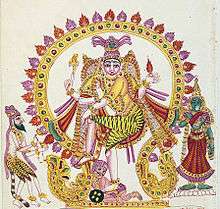Bhringi

According to Hindu mythology, Bhringi was an ancient sage (rishi), and a great devotee of Shiva,[1] the Hindu God of destruction and rejuvenation. According to mythology, all the rishis paid homage to both Shiva and Parvati,consort of Shiva, but Bhringi would not worship Parvati and dedicated himself solely to Shiva.
The story goes that Bhringi one day, came to Mount Kailash, the abode of Shiva, and expressed his desire to go around Shiva. As he was going around, Shiva’s consort, Shakti, said, “You cannot just go around him. You have to go around me too. We are two halves of the same truth.”
Bhringi, however, was so focussed on Shiva that he had no desire to go around Shakti. Seeing this, Shakti sat on Shiva’s lap making it difficult for Bhringi to go around Shiva alone. Bhringi, determined to go around Shiva took the form of a Bhring (Black Bee) and tried to slip in between the two.
Amused by this, Shiva made Shakti one half of his body – the famous Ardhanarishvara form of Shiva. This was God whose one half is the Goddess. But Bhringi was adamant. He would go around Shiva alone. So he took the form of a rat, some say a bee, and tried to gnaw his way between the two.
This annoyed the Goddess so much that she said, “May Bhringi lose all parts of the body that come from the mother.” In Tantra, the Indian school of alchemy, it is believed that the tough and rigid parts of the body such as nerves and bones come from the father while the soft and fluid parts of the body such as flesh and blood come from the mother. Instantly, Bhringi lost all flesh and blood and he became a bag of bones. He collapsed on the floor, unable to get up.
Bhringi realized his folly. Shiva and Shakti make up the whole. They are not independent entities. One cannot exist without the other. Without either there is neither. He apologized.
So the world never forgets this lesson. Bhringi was denied flesh and blood forever. To enable him to stand upright he was given a third leg, so that his legs served as a tripod.
References
- ↑ Gopal, Madan (1990). K.S. Gautam, ed. India through the ages. Publication Division, Ministry of Information and Broadcasting, Government of India. p. 78.
